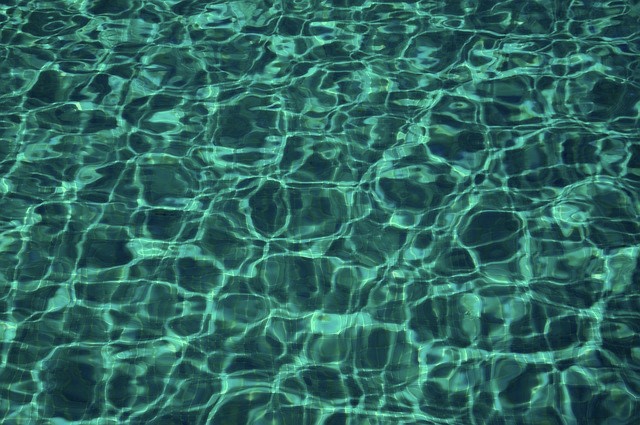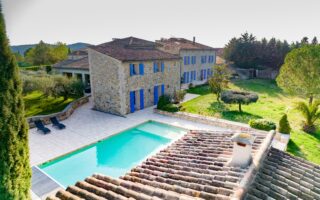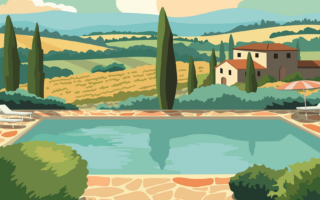Treating a Green Pool in France


Help! My Pool’s Gone Green…
It doesn’t matter how well we look after our pools, at some time, for one reason or another, the chances are you will have to battle with a green pool.
In an ideal world a pool should always be kept filtered, chemically balanced, clean, winterized and opened correctly to reduce the risk of algae and other problems common with pool ownership.
Following many questions, and a few “worrying” phone calls, I decided to write a few lines on the subject, this is not by any means going to answer everything as water chemistry in pools can be as simple as adjusting pH and Chlorine for some and as complicated as a degree in Astro-physics for others!!!
I remember one call from a chap who told me his pool “fizzed” when he put chlorine in, turns out there were so many chemicals in the pool as a result of him trying to “get the bloody thing clean” that I wouldn’t be surprised to see the extendable pole and net “melt” if it went in the water, we worked out it would have saved him over 200 Euros and saved 10 days if he had just done as we suggest below…
(Everything below doesn’t do away with the fact that a pool, correctly looked after, should never go green, or be allowed to go green in the first place).
“Help my pool is green, what can I do?”
My first response to this question may sound a bit daft but it is usually “How green is it?” What difference does this make? Well, it reaches a point when treating your pool with chemicals that turning a stagnant smelling pond into a crystal clear lagoon becomes both cost prohibitive, time consuming and really just not the smart thing to do.
Imagine being asked to get in a bath after someone who has just been dunked into a cesspit and perhaps also left something unpleasant floating for example, (sorry), even though some chemicals have been added to make the water look clear, it had been filtered and with the promise that all the bugs are now dead, would you??
Hopefully the answer is noooo, not on your Nelly, Yuk no chance or something similar, so why is it so many people are quite happy to spend weeks and literally hundreds of Euros to do something similar with their pool water? After too much shocking with chlorine, pH balancing with it swinging too high and too low, anti-algae treatment, flocculants, clarifiers, water line cleaners etc, etc what you can end up with after a period of time is clear water with a mixture of chemicals and byproducts that can render some treatments ineffective, there can be traces and other products in your waters make up that can be detrimental to your health, can affect your pools surface and cause other costly or on going problems. True enough, the products kill bugs, the filter takes out a lot of particles, clarifiers clear the water but at what cost?
As a pool owner you should get into the habit of changing at the very minimum 25% of your pools water every year, in many cases the winterizing process means you have to do this anyway after dropping the pools water level over winter, when you reopen, you top the pool up, but if you leave it full or have a floating cover which means keeping the water level high, when you put it back into service a partial water change is one of the best things you can do.
Water in comparison to pool chemicals is cheap, it’s also clean and should be pH balanced so changing old, green or “dirty” pool water for fresh tap water is the CHEAPEST, QUICKEST and MOST EFFECTIVE option for getting a green pool back into service, this is my advice for anyone with a green sludgy or troubled pool, start here, then see below.
N.B. When changing pool water, never change all the water in one hit unless you know that your pools structure can cope with it! Liner pools/panel pools should be drained to around 50% at the most, refilled and drained again maybe several times so as to dilute the water, if you drain it down completely the liner can move or get water in behind it from a high water table, either way you will end up with creases or possibly panels collapsing.
Did you know?
A liner pool, incorrectly balanced, can grow wrinkles! Look after your pH; check it every timeBEFORE you add any chemicals, after rainfall and every time you carry out your pool maintenance.
Everything that ends up in your pool contains PHOSPHATES, hair, skin, grass, leaves, birds%*t etc, Phosphates are algae food, get rid of this and you reduce even more the chance of getting algae in the first place.
Anyway back to green pools… If your (chlorine/bromine) pool has gone green due to perhaps a pump failure, after a storm, after missing a cleaning routine etc there are several things you can do.
Firstly CHECK pH, if it is way out try and get it back to between 7.2 and 7.4pH before going any further.
Use an anti algae shock and leave your filtration on permanently until your pool is clear, the following day, control pH and add a chlorine shock, leave to take effect for a few hours then add some multifunction tablets to keep the pool topped up with everything it needs. You can also use a chlorine free shock (Hydrogen Peroxide) or active Oxygen treatment if preferred but I have found the HTH Anti-Algae shock about the most efficient product around.
Under normal operating use, your pools filtration should be set to run for half of the water temperature in running hours, for example if it is 24 degrees you should be running your pump for 12 hours a day, you should filter during the hottest hours of the day (as this is when algae growth is most likely to occur) also when the pool is being used (people swimming stir up debris and deposit more).
Depending on the type of filtration you have (we recommend changing over to Zel’eau, a Zeolite crushed volcanic rock) and how effective it is, you may find your pool clears completely within a day or so, in which case carry on doing a regular pH check, chlorine shock once a week, multifunction tablets on a permanent basis and a preventative anti-algae treatment once a fortnight at the very least, it is a popular misconception that chlorine is to kill algae so don’t just keep adding chlorine thinking it will cure the problem, high levels of chlorine will kill algae but it is designed to be kept at around 1ppm to kill bacteria, higher levels of free chlorine can not only be detrimental to your health, it can bleach hair and bathing suits, take the colour out of fiberglass pools or liners so use a good anti algae control and the only raised levels of chlorine should occur directly after a chlorine shock, this effectively “resets” your pools Chloramines levels (byproduct of chlorine use) and makes sure all bacteria is killed.
But it’s still “cloudy!”
If you find yourself in a situation where your pool is cloudy after a shock algaecide or chlorine and there are miniscule white particles in the water this is most likely dead algae, again it depends what filter media you have but it will be passing right through your filtration and just keep circulating in the pool, in these cases a flocculent should be used (you don’t need this with Zel’eau) to “clump” all of the microscopic particles together, add a liquid flocculent, circulate for a couple of hours, then TURN OFF your filtration overnight, in the morning all of the particles will have clumped together and fall to the bottom of the pool, you can now Hoover the pool DIRECTLY TO WASTE (this bypasses the filtration so there is no risk of the fine debris coming back into the pool).
For maintenance purposes you can use flocculent socks or tablets that go into your skimmer to trap particles into the filter bed instead of the pools floor, we recommend Sparkle Plus as it last for 2 months, it not only flocks but it is a clarifier and most importantly a Phosphate remover, you may have to do the above clean to waste a few times, it all goes back to what shade of green you had to start with, once you get most of the dead algae out of the pool pHree and clear or Sparkle Plus will get rid of any fine turbidity (cloudiness) within a matter of hours.
If you don’t have the facility to clean to waste, as is in the case of some pools such as Desjoyeaux, Waterair, Christal and other makes of filtration using cartridges or bag filters, the only option is to rig up a separate pump to use with your cleaning kit to do the same job, a submersible pump is no good you need a small pool or well pump with a debit of around 5m3/hr and definitely self priming.
There are other causes of algae, cloudiness and chemicals not doing what they are designed to do, if your pool has heavy metals in it (this is common when well water is used) it can come about by having a treated decking around the pool instead of hardwood, if you have too much stabilizer (Cyanuric Acid found in most chlorine products) if your calcium hardness is too high/low etc you may notice that chemicals just aren’t working, the only way to sort this out is by using fresh mains fed water, if you really can’t bring yourself to “throw all that water away” change at least 50%if you insist that your well or source water is better than what is coming out of the tap at the very least use a carbon pre filter to make sure there are not metals present and you take out as much sediment as you can.
Leaves will always leave (pardon the pun) little green marks on a pool if left to sit for any period of time, remove leaves on a regular basis before hovering (to reduce the amount that end up in the filter) with either a surface or bottom net. Even better if you can get rid of any overhanging trees, plants etc the better it is, not only are there phosphates in the leaves but the pollen and roots can cause havoc with your pool.
Use a footbath (with a small amount of chlorine in) to remove grass and dirt before people use the pool, if you add a solar shower they can have a good rinse off before going near the water, it is a sad fact that some of the great unwashed think a dip in your pool is as good as a bath once a year!!
Salt pool problems
It would generally be true to say that salt pools do not suffer from algae growth as much as chlorine pools but if yours is turning there are several things to check. Firstly do you have enough salt in the pool? Most salt chlorination devices will need anything up to 4 grams of salt per ltr of water so to start with you need to make sure you have enough, if there is insufficient salt dissolved in the water a chlorination device cannot turn it into chlorine so make sure you add at least 5kg of salt per mtr cubed in new pools and maintain a level of around 3000-4000ppm at all times, never more than 7000ppm.
If your salt level is good you need to make sure your cell is working correctly, normally they give off bubbles when the electric charge is passed through, some cells have a reversed polarity and are known as “self cleaning” if you do not have this type of cell you will have to take it out and clean it in a solution of 1 part Hydrochloric acid and 5 parts water if it gets “furred up” this can depend on calcium hardness, water temperature, composition of the pool etc but an average salt cell only has a life expectancy of 3-5 years in any case.
Check your chlorine level, if your salt cell is working well you should see a chlorine reading of up to 1ppm, make sure you have enough stabilizer (Cyanuric acid), in the case of Chlorine pools usually you have plenty as it is in most chlorine products, however in a salt pool there is no stabilizer so you may need to add some to maintain a level of around 60-80ppm.
As with chlorine pools there is always the chance that phosphate levels are high in a salt pool so use Sparkle Plus (Phosphate cube) or another phosphate remover to keep it at bay.
Pools are not ponds!
Share to: Facebook Twitter LinkedIn Email
More in food, garden, health, people, swimming pools, work
By FrenchEntrée
Leave a reply
Your email address will not be published. Required fields are marked *




REPLY
REPLY
REPLY
REPLY